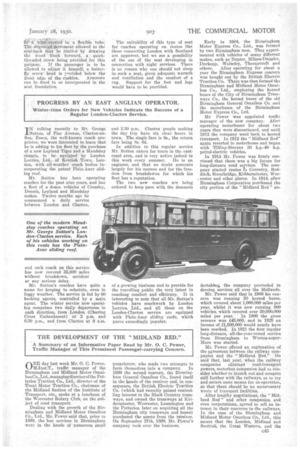Phases of PASSENGER TRAVEL
Page 66

Page 67

If you've noticed an error in this article please click here to report it so we can fix it.
Notes on a Variety of Aspects of Coach and Bus Travel A COACH SEAT THAT OVERCOMES CRAMP.
The Passenger's Comfort Ensured by Providing for Movement of the Seat-back and Cushion.
WE have been considering a type of self-adjusting coach seat that Las been developed by Mr. R. W. Bird, who was for many years with Messrs. Strachan and Brown, of Acton, Loudon, W.3, before that concern was reorganized as a limited company. It embodies two or three patents, the last of which has only just been applied for, and its design now seems to be completely rounded off, so to speak, the seat being in every respect ready for the coachbuilder. It appears to fulfil a long-felt want.
Mr. Bird appreciates two things about coach travel. The first is the simple axiom that the passenger requires support for the small of the back and beneath the knees. Everybody knows this, but not every seat maker allows for it. The second is that, to ensure comfort on a long motor-coach journey, the passenger's natural desire to change position from time to time must be catered for. The difficulty was to put these ideals of design into a practical form.
The first point to be made clear about the Resteze seat is that the cushion and back-rest for each passenger are separate, even when double seats of the popular transverse type are being made. The foundation of the seat is a bucket-shaped back-and-base combination, rigidly made of sheetmetal or plywood, and this is supported on any suitable type of leg frame.
The scatlpack proper, which is fully upholstered and fits snugly to the waist and shoulder's, is attached to the top of the foundation by sprung hinges, so that it can be pressed backward at the top and will spring forward again. The bottom edge of it is hinged to the top frame of the seat cushion, this being made of a welded iron rod, and the hinge here is simply provided by steel strips or eyes. Thus, when the seat-back is pressed backward, the cushion will ride forward, the rear end of it rising slightly. The seat cushion LS built up in the ordinary fashion except--and herein lies the subject of one patent—that rolled spring-steel strip is employed to give a forward edge that will be comfortable under the knees and will not lose its resiliency after some nionths of wear.
It will he plain from the above description that the passenger has only to lean backward, as if in search of a more comfortable position, to cause the contour of both seat-back and cushion to conform to his needs. In fact, the • comfort of the seat is remarkable.
The inventor has realized that, in certain eases, it may not be desirable for the seat-hack to be unlimited in its movement. He therefore provides, if required, a steel trough screwed longitudinally upon the nnder-side of the seat foundation ; in this slides a wood block that is linked to the seat-hack &*. ,..garried in a flexible tube:
Tiii4..dggk*ove.rnent allowed to the Seat-back -May .be limited by drawing theWood 'Ailock forward, a quicktbreaded screw being provided for this
purpose. If the passenger is to be allowed to adjust it himself, a butterfly: serew head is oeovided below the front edge of the cushion. Armrests can be fixed to or incorporated in the seat foundation. • The suitability of this type of seat for coaches operating on routes like those connecting London with Scotland are apparent, but we see a possibility of the use of the seat developing in connection with night services. There is no reason why one should not sleep in such a seat, given adequate warmth and.ventilation and the comfort of a rug. Support for the feet and legs would have to be provided.












































































































